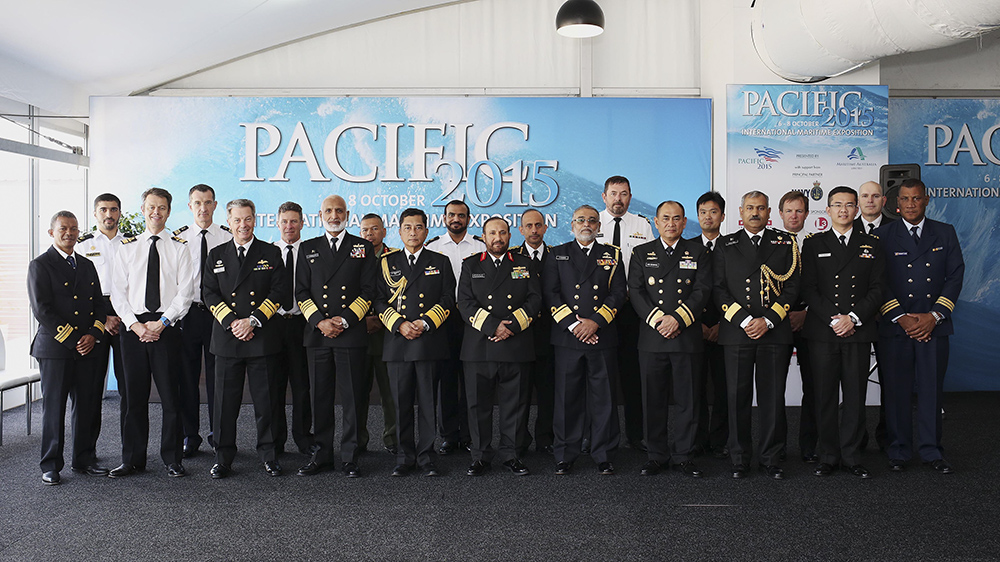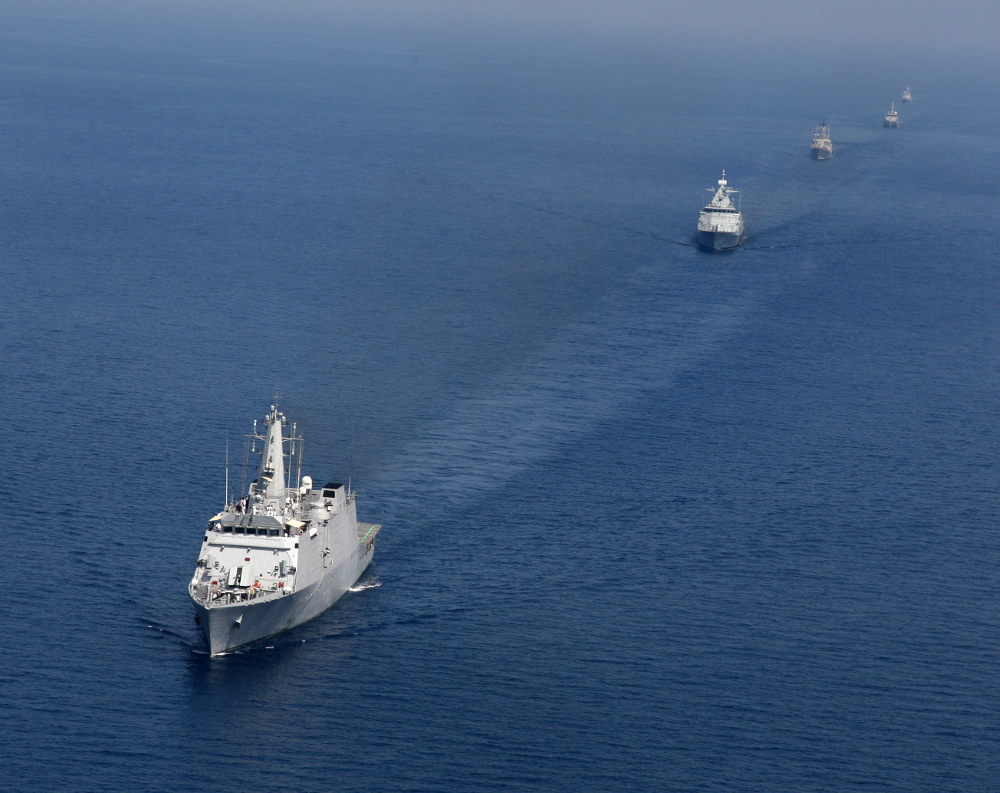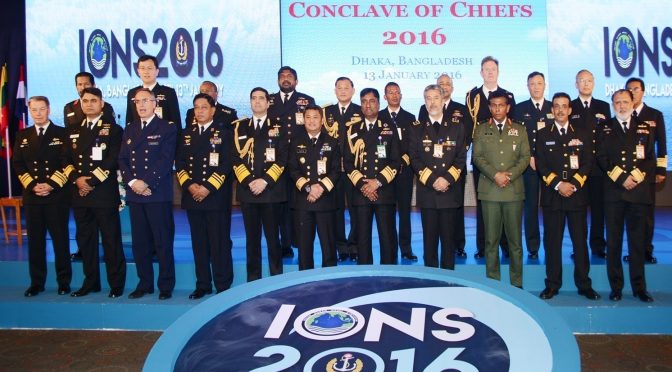By Vice Admiral Pradeep Chauhan AVSM & Bar, VSM, IN (Ret.)
Conceptual Underpinning
The concept of Constructive Engagement is foremost amongst the various strategies that India has adopted in the furtherance of her security. Consequently, this is a strategic concept that shapes much of India’s geopolitics.
Traditionally, security used to be thought of only in terms of the defense of territory within a state system whose defining characteristic was an incessant competition for military superiority with other nation-states, all lying within a classic state of anarchy, devoid of superior or governing authority. Today, however, India and her Navy have swung around to a far more holistic approach. This changed approach finds its historical moorings in the famous “Common Security” report that had been authored as long ago as 1980 by the “Independent Commission on Disarmament and Security Issues” chaired by the late Prime Minister of Sweden, Mr. Olaf Palme. This report emphatically drew attention to alternative ways of thinking about peace and security by formally acknowledging that common security requires that people live in dignity and peace, that they have enough to eat, and are able to find work and live in a world without poverty.
While military maritime security does, of course, continue to enjoy primacy for India, existing as it does in a world-system defined by Westphalian concepts of national sovereignty, new terms such as ‘Non-Traditional Security’ and ‘Human Security Issues,’ largely drawn from the 1994 Report of the UNDP, have made their way into maritime India’s contemporary security-lexicon and lodged themselves within its collective security-consciousness. Maritime Security is now firmly established within a new construct that incorporates military, political, economic, societal, and environmental dimensions, and recognizes the many linkages between them.
Thus, threats to human-security, such as religious extremism, international terrorism, drug and arms smuggling, demographic shifts — whether caused by migration or by other factors, human trafficking, environmental degradation, energy, food, and water shortages, all now figure prominently as threats that are inseparable from military ones. These have led to the formulation of new concepts such as ‘comprehensive security’ and ‘cooperative security.’ Clearly, however, security issues within the maritime domain need to be referenced more towards common interests rather than threats. At a regional level, it is these very Human Security issues that have been mentioned above that constitute common interests. It is a common regional interest to create and consolidate a region in which the comity of nations is both intrinsic and assured and where every nation, big or small, is treated as an equal. Multiple options of governance must be recognized functions of the independent choice of the people of each nation-state. The state protects the individual and the individual preserves the state in a symbiotic relationship designed to establish and spread stability across the region where malevolent non-State entities should find neither spatial nor temporal room for maneuver. In sum, then our common interests are the absence-of or freedom-from threats. It is therefore appropriate that within the maritime domain, the concept of Maritime Security is increasingly being described as a condition characterized by “freedom from threats arising either in or from the sea.”[1] These threats could arise from natural causes or from manmade ones, or from the interplay of one with the other, as in the case of environmental degradation or global warming. Insofar as the targets of such threats (arising from a lack of maritime security) are concerned, these could be individuals themselves — or ‘groupings’ of individuals, such as societies and/or nation-states. When these threats address the regional fabric itself, nation-states find themselves increasingly enmeshed in a complex web of security interdependence, which tends to be regionally focused and a robust regional initiative ought to be a logical outcome of this regional focus.

Multilateral Maritime-Security Constructs
Although the Indo-Pacific region has several manifestations of the regional drive towards cooperative security through Constructive Engagement, most of them lie in the Pacific. Examples include ASEAN, ASEAN+3, APEC, ARF, the 6-Party Talks, the East Asia Summit, etc. At the Navy level, the Western Pacific Naval Symposium (WPNS) is clearly an important multilateral security construct.

The Indian Ocean segment of the Asia-Pacific littoral is now beginning to catch up. However, for much of the Twentieth Century such sub-regional geopolitical constructs that did emerge within the Indian Ocean remained limited to West Asia and southern Africa (the Arab League in 1945, the SADC in 1980 and the GCC in 1981). There was nothing to be found at a pan-regional level that might knit together at least a significant proportion of the 37 littoral nation-states of the Indian Ocean and its rim. It was not until the closing years of the Twentieth Century that a Mauritian-led initiative fructified and led to the launch, in March of 1997, of the clumsily-named ‘Indian Ocean Rim – Association for Regional Cooperation’ (IOR-ARC). However, for the first decade-and-a-half of its existence, this grouping confined itself purely to economic cooperation and specifically abjured security issues. It must, of course, be admitted that in 1997, the notion of security within the collective minds of the countries of the Indian Ocean was still very strongly biased towards military security alone. 2013 was a watershed for the organization, for in that year, the IOR-ARC was renamed ‘Indian Ocean Rim Association’ (IORA)[2] and identified six priority areas to promote the sustained growth and balanced development of the region, of which ‘maritime safety and security’ is the first priority[3]. The IORA also indicated that it was important that its work on maritime security and safety and disaster management should be aligned with and complement possible IONS (Indian Ocean Naval Symposium) initiatives in these areas. However, not much seems to have been done to date. The IORA does not have a working group to deliberate on these issues, nor does it have an institutional link with IONS[4].
IONS: Development
In February of 2008, driven by the need to address regional vulnerabilities by capitalizing upon regional strengths, the Indian Navy made a stupendous effort to assemble in New Delhi the Chiefs-of-Navy of very nearly all littoral states of the Indian Ocean Region. Sitting and discussing together — for the first time ever — both in ‘assembly’ and in ‘conclave,’ the chiefs launched the Twenty First Century’s first significant international maritime-security initiative — namely, the Indian Ocean Naval Symposium, or ‘IONS.’ That the launch of so important a regional initiative was able to meet with such wide acceptance across the length and breadth of the Indian Ocean was in itself a unique phenomenon — but one representative of a region that is beginning to come into its own and seems ready to evolve a broad consensus in facing the myriad security challenges within the maritime domain.
The acronym ‘IONS’ is an appropriate one, since the etymology of the English word ions is drawn from the Greek word ienai meaning go, and implying movement. The fundamental concept of IONS, too, remains one of ‘moving’ together — as a region. Under the IONS construct, the 37 littoral states of the Indian Ocean Region have been geographically grouped into four sub-regions, as depicted:
| West Asian Littoral | East African Littoral | South Asian Littoral | South-East Asian & Australian Littoral | ||||
| 1 | Bahrain | 1 | Comoros | 1 | Bangladesh | 1 | Australia |
| 2 | Iran | 2 | Djibouti | 2 | India | 2 | Indonesia |
| 3 | Iraq | 3 | Egypt | 3 | Maldives | 3 | Malaysia |
| 4 | Israel | 4 | Eritrea | 4 | Pakistan | 4 | Myanmar |
| 5 | Jordan | 5 | France | 5 | Seychelles | 5 | Singapore |
| 6 | Kuwait | 6 | Kenya | 6 | Sri Lanka | 6 | Thailand |
| 7 | Oman | 7 | Madagascar | 7 | Timor Leste | ||
| 8 | Qatar | 8 | Mauritius | ||||
| 9 | Saudi Arabia | 9 | Mozambique | ||||
| 10 | UAE | 10 | Somalia | ||||
| 11 | Yemen | 11 | South Africa | ||||
| 12 | Sudan | ||||||
| 13 | Tanzania | ||||||
The formal launch of the IONS initiative was effected through the inaugural ‘Conclave-of-Chiefs.’ This conclave is held once every two years, with a new chairperson at the helm. As had been the intention from the start, it is at this ‘Conclave-of-Chiefs,’ removed from the glare of the media, that the most meaningful progress occurs in accordance with a formalized ‘Charter of Business.’ It is a matter of very great satisfaction that the Charter-of-Business has already been adopted, especially if it is recalled that the WPNS Charter took 12 years (from 1988 to 2000) to receive formal approval from all its constituent members.

Every Conclave-of-Chiefs — there have been eight held thus far — is supplemented by an IONS Seminar, which the Chiefs also attend, along with a galaxy of luminaries in various disciplines relevant to security within the maritime domain. The inaugural IONS Seminar was jointly conducted by the Indian Navy and the National Maritime Foundation (NMF), at the Vigyan Bhavan, New Delhi, on 14 and 15 February 2008. The theme of that seminar was “Contemporary Transnational Challenges — International Maritime Connectivities” — a subject that has grown in relevance over the years.
IONS is a unique regional forum through which the Chiefs-of-Navy of all the littoral states of the IOR can periodically meet to constructively engage one another through the creation and promotion of regionally relevant mechanisms, events, and activities related to maritime security. Yet, given the diversity of the region as a whole, there has been an acute awareness of the need to make haste slowly. Successive Conclaves-of-Chiefs have, therefore, very deliberately spent time and great effort in building the foundation of the construct through an incremental series of small but crucial confidence-building steps.
Although IONS was an Indian initiative, it was designed from the very beginning to be a pan-regional construct rather than a country-specific one. Hence, the chairmanship of IONS rotates sequentially through each of the four sub-regions. This also ensures that the somewhat different priorities given even to common challenges, and, of course, such maritime-security challenges as are unique to a given sub-region, are all given the emphasis and attention they deserve. The first rotation through all sub-regions has already been completed with the Chiefs of Navy of India (2008-2010), the UAE (2010-2012), South Africa (2012-2014), Australia (2014-2016) all having sequentially chaired IONS. The chairmanship is currently held by the Chief of the Navy of Bangladesh (2016-2018). Pakistan participated for the first time at the level of its Navy Chief in 2014.
Conscious of the need to avoid being perceived as merely a one-in-two-years talk-shop, each Conclave-of-Chiefs sets forth a consensual agenda of specific activities designed to keep the region involved and engaged with various elements of maritime security. Some activities — such as the IONS Essay competition — might appear unduly humble in their scope, but they are essential to sustaining awareness of this regional construct and what it stands for, especially amongst younger generations of maritime security experts whose involvement will be crucial for IONS to continue to be perceived as relevant across generational shifts of personnel.
The Need for more Proactive Initiatives
And yet, it must be admitted that the movement has sometimes erred on the side of excessive caution. As the midwife of the IONS construct and its permanent secretariat, India must take its fair share of blame for allowing the movement to drift. Indeed, it has appeared — on more than one occasion — that the Indian Navy, having created such a fine instrument, has demonstrated a certain lack of initiative and dexterity in wielding it. Opportunities have consequently been lost. For instance, the anti-piracy missions stretching from the Gulf of Aden all the way to the waters of Seychelles and Maldives, were an excellent opportunity for national maritime security agencies — even while operating essentially alone — to have done so under a nominal IONS-umbrella.
Likewise and more recently, in January 2016, the U.S. Combatant Command AFRICOM, sponsored a maritime exercise named CUTLASS EXPRESS, whose scenarios were designed to test the ability of participating naval ship-crews to respond to illicit trafficking, piracy, illegal fishing, and search-and-rescue (SAR) situations. While there is little doubt that this is beneficial for stability as a whole, it also represents yet another lost opportunity for India to have taken the initiative to leverage IONS into undertaking activities that go beyond baby-steps.

Even in a region as sensitive (if not outright ‘prickly’) as the Indo-Pacific, HADR (Humanitarian Assistance and Disaster Relief) exercises and operations are amongst the most readily acceptable and regionally useful activities. Building upon the effectiveness of the humanitarian relief provided by the hospital ship, the USNS Mercy in the aftermath of the tsunami-earthquakes of 2004 (Indo-Pacific) and 2005 (Java, Indonesia), the Hawaii-based headquarters of the U.S. Pacific Command (PACOM) launched “Pacific Partnership” HADR missions to provide succor and relief across the PACOM ‘Area of Operations’ (AOR). It invited the militaries of all nations within its AOR to partner in these annual humanitarian missions. The Mercy deployed on these missions every alternate year, while the US Navy deployed an LPD in the ‘gap’ years. India initially responded admirably, sending multi-disciplinary medical and associated support-personnel, drawn from all three Armed Forces, aboard the USNS Mercy and the USS Peleliu, for three years — 2006, 2007, and, 2008. The contribution of Indian Armed Forces medical and support personnel in providing medical succor and humanitarian relief to stricken people in Bangladesh, Indonesia, the Philippines, Timor-Leste, the Marshall Islands, Vietnam, Papua New Guinea and Micronesia, over the last three years has been both significant and extremely well-appreciated. However, even the noblest of initiatives are subject to political and perceptual vicissitudes. Thus, after these three years, Indian participation ceased — presumably because the exercise, no matter how regionally relevant in terms of humanitarian assistance and no matter what the fringe benefits were, was a U.S.-Flag multilateral-construct and not a UN-Flag one. As a result, from 2009 onward, India was conspicuous by its absence and lost a host of opportunities to showcase its Armed Forces in their most acceptable role to a regional audience. In seeking to avoid being ‘seen’ as a partner-nation to the U.S. Navy even within a humanitarian paradigm, India chose not to be ‘seen’ at all — thereby throwing out the baby with the bathwater!
This shortsightedness is doubly ironic because, as outlined in the foregoing paragraphs, the Indian Navy had already launched IONS in a hugely successful manner and, in the ensuing years the country had a golden opportunity to leverage the enormous potential of regional HADR maritime missions by launching HADR Missions within the Indian Ocean region under the aegis of IONS. Several IONS navies could meaningfully sustain such missions by sequentially (or simultaneously) fielding one or more of their amphibious ships. The Indian Navy has several large Landing Ships — including the LPD, INS Jalashwa — one or more of which could be deployed. Despite several such opportunities having been lost in the past, there is some solace in knowing that in Dhaka this year the Indian Navy presented a guidance document on HADR to the assembled Chiefs of Navy — and not a day too soon!
Would the U.S. Navy be willing to partner such an IONS-led series of maritime HADR missions? The answer is an emphatic Yes. This is borne out by the continuing U.S. keenness to engage with India. Witness the U.S. DoD’s 2011 “Report to Congress on U.S.-India Security Cooperation,” Page 7 of which states, “In the next five years, the United States will continue to request India’s participation in future PACIFIC PARTNERSHIP missions, the annual U.S. Pacific Fleet HA/DR event in the USPACOM area of responsibility. Indian inclusion would provide an opportunity to apply HA/DR lessons learned in other forums to a humanitarian civil assistance scenario with overlapping skill set requirements, and prepare for combined operations in an actual HA/DR event.” [5]
Finally, it is well to recall that in the late 1980s, the eminent strategic analyst and prolific writer, Barry Buzan, articulated the concept of a ‘Regional Security Complex’ to describe “…a group of states whose primary security concerns link together sufficiently closely that their national securities cannot realistically be considered apart from one another.”[6] It is probably premature to apply this term in its entirety to the Indo-Pacific but we certainly appear to be heading that way, and movements such as the IONS might well end-up consolidating the region into a ‘Maritime Regional Security Complex.’ Governments of the region and their Foreign Offices must provide the maximum possible traction to the IONS construct as this is the only one likely to yield regional coherence on issues of maritime security.
Vice Admiral Pradeep Chauhan retired as Commandant of the Indian Naval Academy at Ezhimala. He is an alumnus of the prestigious National Defence College.
[1] Address by Dr Manmohan Singh, erstwhile Prime Minister of India, inaugurating the Indian Ocean Naval Symposium (IONS) Seminar at New Delhi, 14 February, 2008; available at url: http://archivepmo.nic.in/drmanmohansingh/speech-details.php?nodeid=633
[2] 13th Meeting of the Council of Ministers of the Indian Ocean Rim Association — Perth Communiqué, 01 November 2013; available at url: www.iora.net/media/139388/perth_communiqu__2013.pdf
[3] IORA Website; available at url: http://www.iora.net/about-us/priority-areas.aspx
[4] Commodore Gopal Suri; “Case for a Regional Maritime Construct in the Indo-Pacific”, Vivekananda International Foundation Occasional paper – January 2016; available at url: http://www.vifindia.org/sites/default/files/case-for-a-regional-maritime-security-construct-for-the-indo-pacific.pdf
[5] http://www.defense.gov/pubs/pdfs/20111101_NDAA_Report_on_US_India_Security_Cooperation.pdf
[6] Barry Buzan; “People, States & Fear: An Agenda for International Security Studies in the Post-Cold War Era”;
ECPR Press, 2nd edition, University of Essex, Colchester, UK; Reprint: 2009, p. 160

